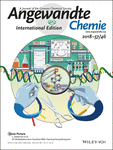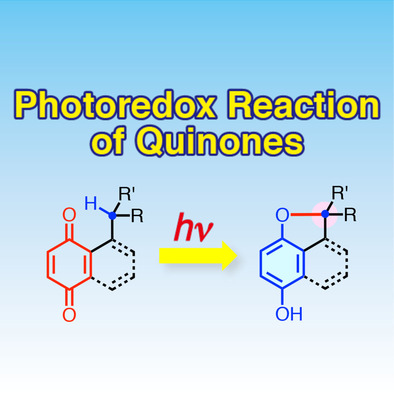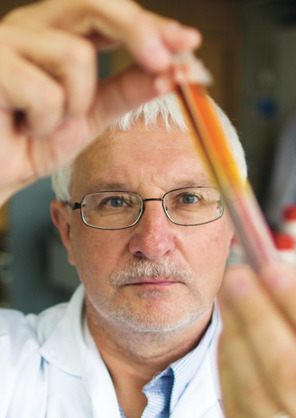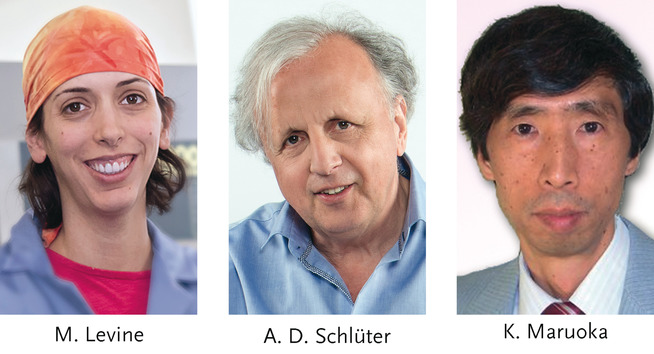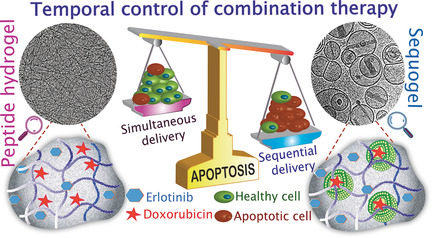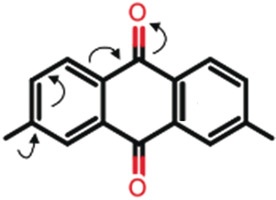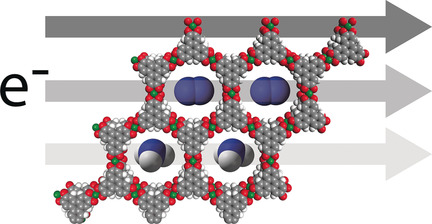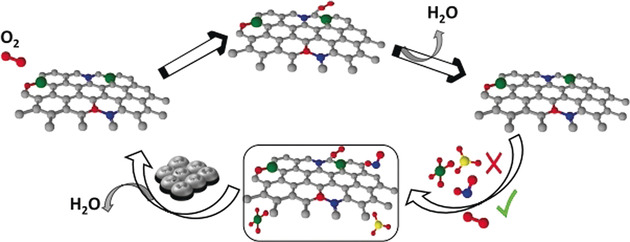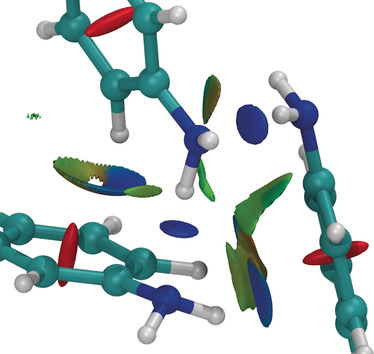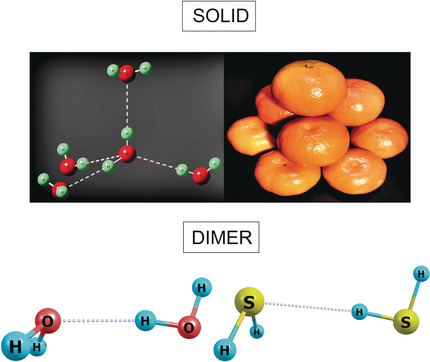Journal list menu
Export Citations
Download PDFs
Cover Pictures
Cover Picture: N6-Methyladenosine-Sensitive RNA-Cleaving Deoxyribozymes (Angew. Chem. Int. Ed. 46/2018)
- Page: 14949
- First Published: 26 October 2018
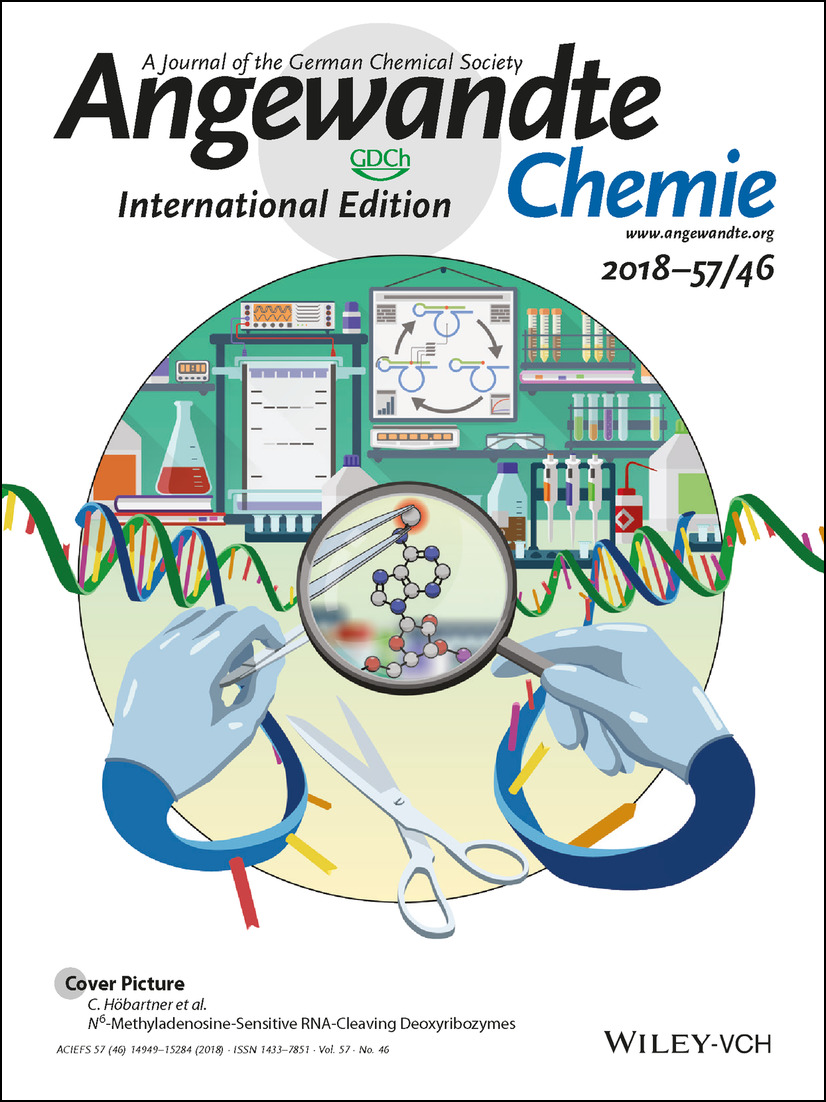
Examination of adenosine methylation in RNA by using deoxyribozymes. In their Communication on page 15117 ff., C. Höbartner and co-workers report new RNA-cleaving DNA enzymes that examine specific adenosines in RNA for the presence of a methyl group at the exocyclic N6-amino group. The DNA enzymes detect m6A, one of the most widespread natural RNA modifications; additionally, they precisely cut the RNA and can be used for the analysis of the RNA methylation status.
Inside Cover: Antibody–Drug Conjugates with Pyrrole-Based KSP Inhibitors as the Payload Class (Angew. Chem. Int. Ed. 46/2018)
- Page: 14950
- First Published: 12 October 2018
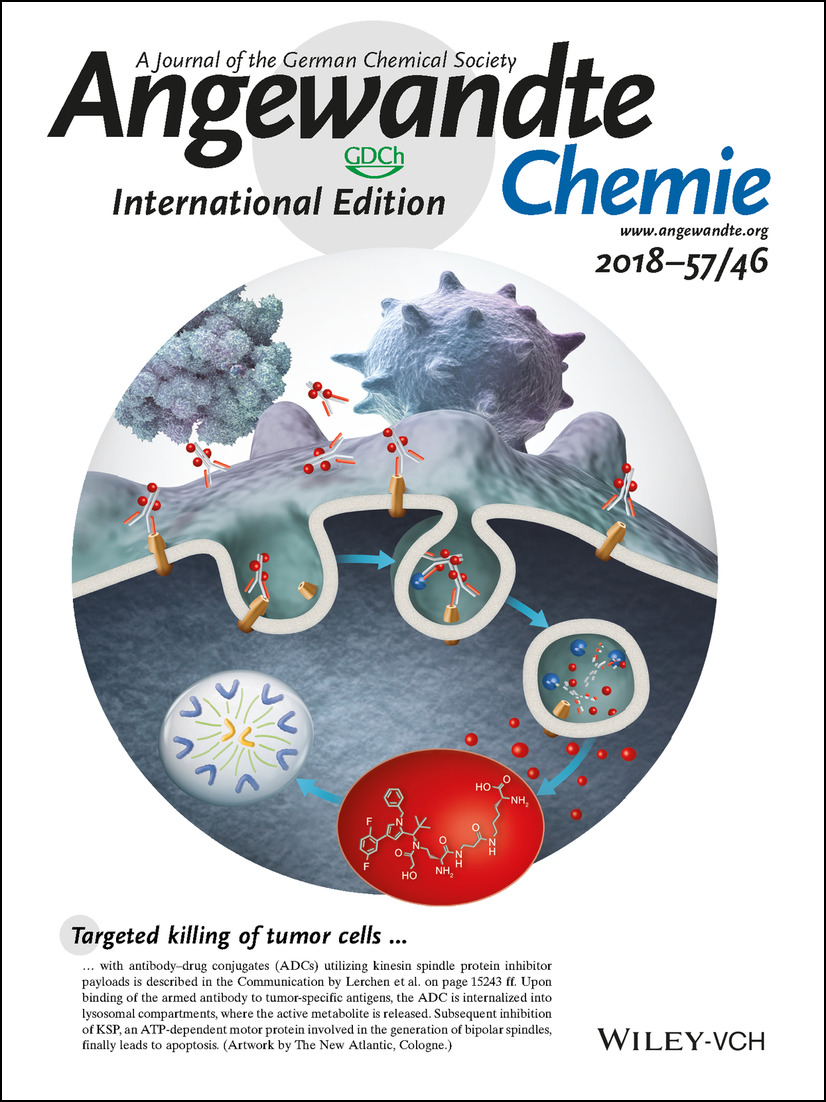
Targeted killing of tumor cells with antibody–drug conjugates (ADCs) utilizing kinesin spindle protein inhibitor payloads is described in the Communication by Lerchen et al. on page 15243 ff. Upon binding of the armed antibody to tumor-specific antigens, the ADC is internalized into lysosomal compartments, where the active metabolite is released. Subsequent inhibition of KSP, an ATP-dependent motor protein involved in the generation of bipolar spindles, finally leads to apoptosis. (Artwork by The New Atlantic, Cologne.)
Inside Back Cover: Reversible Photoswitching and Isomer-Dependent Diffusion of Single Azobenzene Tetramers on a Metal Surface (Angew. Chem. Int. Ed. 46/2018)
- Page: 15283
- First Published: 23 October 2018
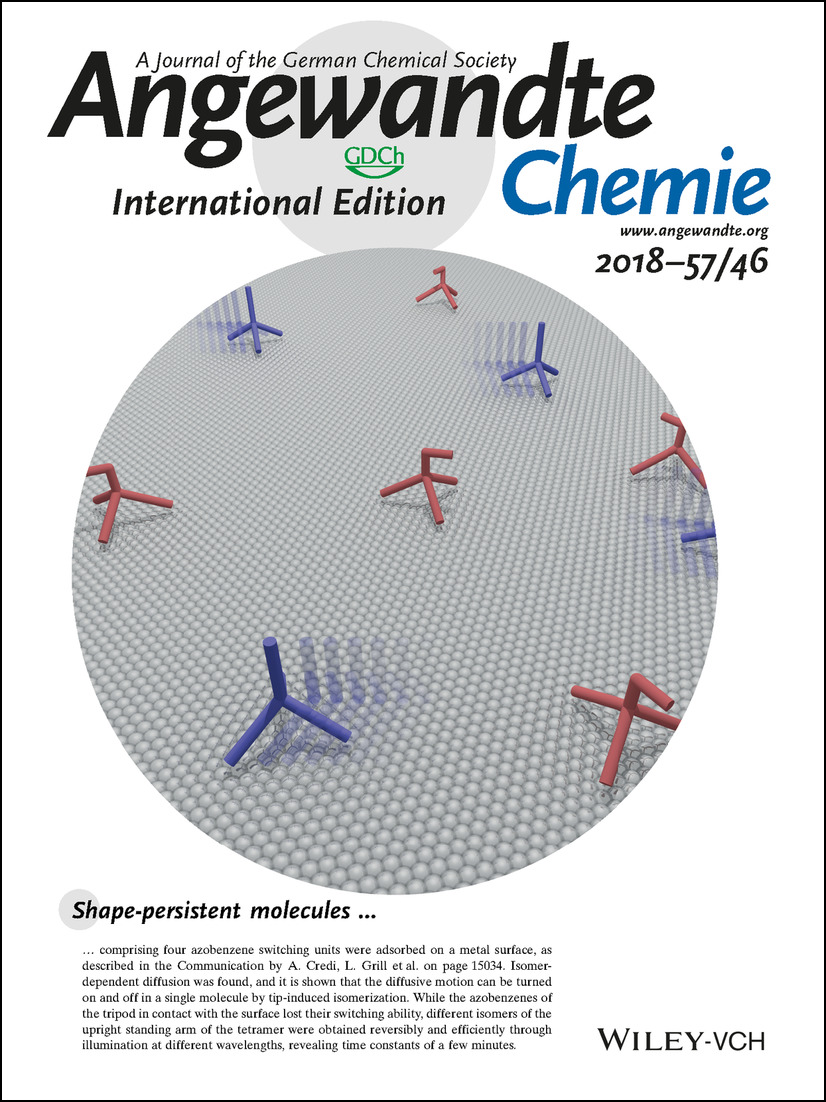
Shape-persistent molecules comprising four azobenzene switching units were adsorbed on a metal surface, as described in the Communication by A. Credi, L. Grill et al. on page 15034. Isomer-dependent diffusion was found, and it is shown that the diffusive motion can be turned on and off in a single molecule by tip-induced isomerization. While the azobenzenes of the tripod in contact with the surface lost their switching ability, different isomers of the upright standing arm of the tetramer were obtained reversibly and efficiently through illumination at different wavelengths, revealing time constants of a few minutes.
Back Cover: The Crystal Structure of a Class of Cyclases that Catalyze the Cope Rearrangement (Angew. Chem. Int. Ed. 46/2018)
- Page: 15284
- First Published: 04 October 2018
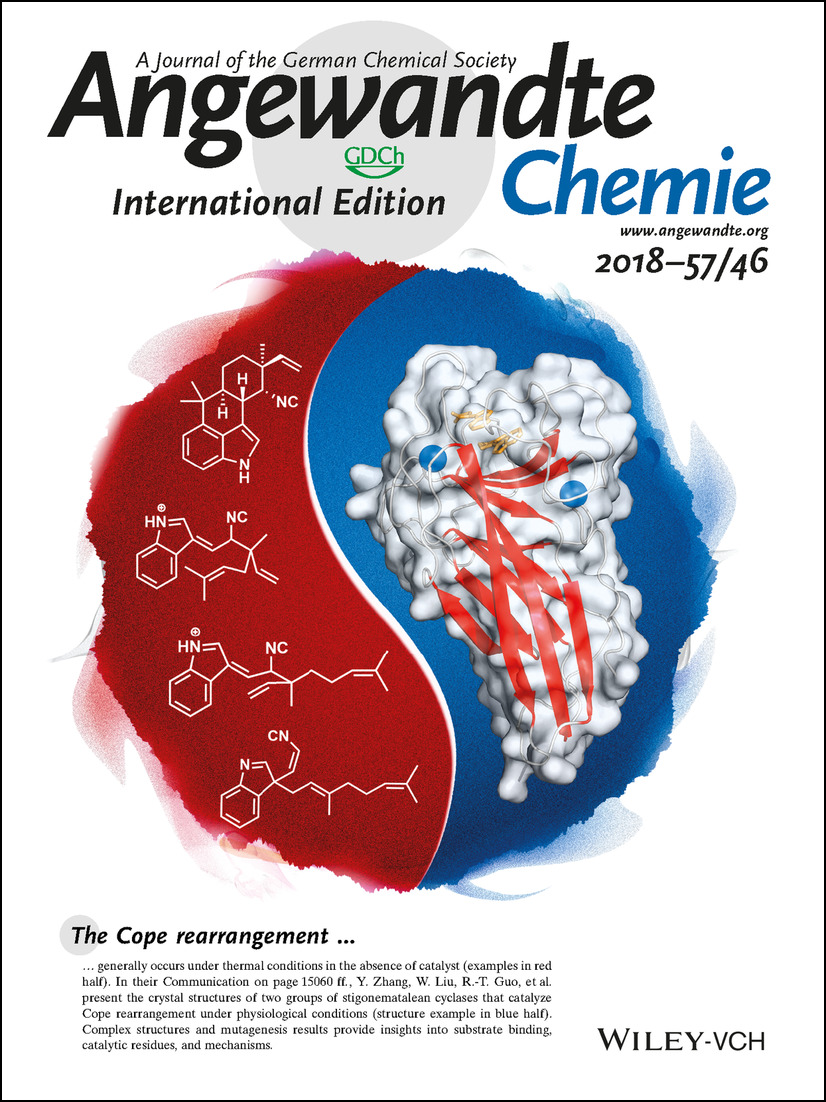
The Cope rearrangement generally occurs under thermal conditions in the absence of catalyst (examples in red half). In their Communication on page 15060 ff., Y. Zhang, W. Liu, R.-T. Guo, et al. present the crystal structures of two groups of stigonematalean cyclases that catalyze Cope rearrangement under physiological conditions (structure example in blue half). Complex structures and mutagenesis results provide insights into substrate binding, catalytic residues, and mechanisms.
Frontispiece
Frontispiece: MXene Aerogel Scaffolds for High-Rate Lithium Metal Anodes
- First Published: 06 November 2018
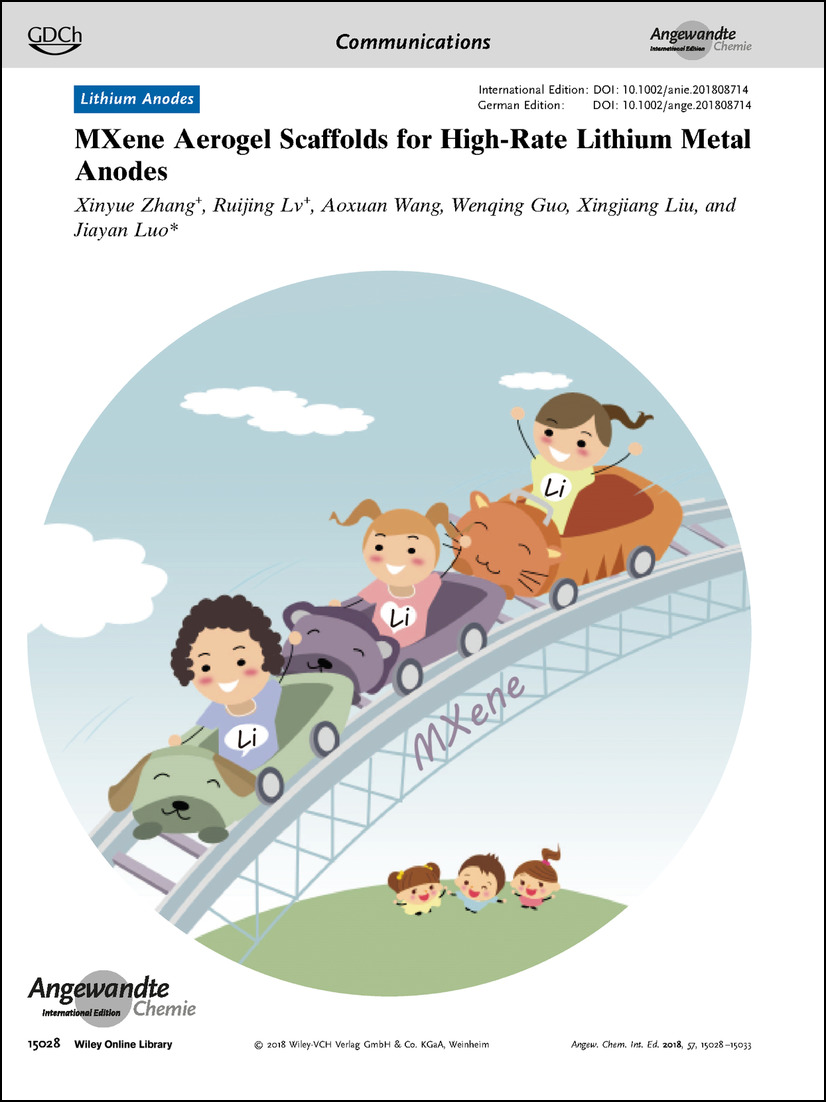
Lithium Anodes. In their Communication on page 15028 ff., J. Luo and co-workers propose 3D porous MXene aerogels as scaffolds for high-rate Li metal anodes with high electron conductivity, fast Li ion transport, and abundant Li nucleation sites.
Graphical Abstract
Graphical Abstract: Angew. Chem. Int. Ed. 46/2018
- Pages: 14953-14970
- First Published: 06 November 2018
Corrigenda
Corrigendum: 7-Step Flow Synthesis of the HIV Integrase Inhibitor Dolutegravir
- Page: 14969
- First Published: 16 September 2018
Corrigendum: Unraveling the Mechanism for the Sharp-Tip Enhanced Electrocatalytic Carbon Dioxide Reduction: The Kinetics Decide
- Page: 14969
- First Published: 13 September 2018
Corrigendum: Structural Revisions of a Class of Natural Products: Scaffolds of Aglycon Analogues of Fusicoccins and Cotylenins Isolated from Fungi
- Page: 14970
- First Published: 11 September 2018
Corrigendum: Palladium-Catalyzed Synthesis of Heteroarene-Fused Cyclooctatetraenes through Dehydrogenative Cyclodimerization
- Page: 14970
- First Published: 21 September 2018
News
Spotlights on our sister journals: Angew. Chem. Int. Ed. 46/2018
- Pages: 14972-14976
- First Published: 06 November 2018
Author Profile
News
Highlights
Reaction Intermediates
The Curious Case of Ketene in Zeolite Chemistry and Catalysis
- Pages: 14982-14985
- First Published: 17 October 2018
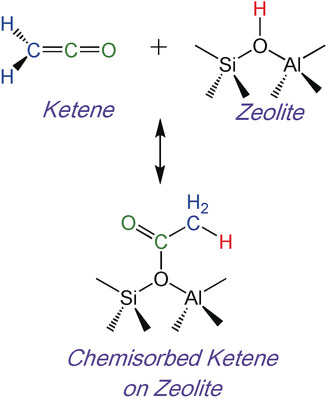
Ketenes in the limelight: The influential role of ketenes has never been adequately acknowledged in zeolite chemistry and catalysis; unlike other first generation highly reactive intermediates, such as carbocations, carbanions, radicals, and carbenes. In fact, the role that ketenes play during catalysis—whether beneficial or detrimental—is a contentious subject that requires further consideration.
Viewpoints
Structural Databases
Glycoinformatics: Bridging Isolated Islands in the Sea of Data
- Pages: 14986-14990
- First Published: 22 May 2018
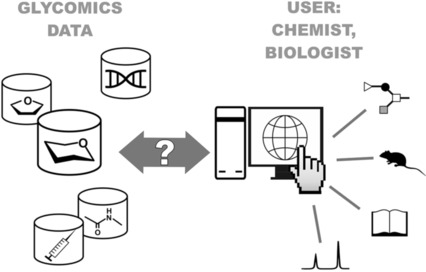
Getting organized: In spite of fundamental roles of carbohydrates in living organisms, the informatization of glycomics is far from complete. The lack of recognized standards, data indices, protocols, and tools, as well as limited connection of the existing projects with each other and with global life-science projects, hinder the successful application of glycoinformatics in modern research.
Minireviews
Metallopolymers
Supramolecular Metallopolymers: From Linear Materials to Infinite Networks
- Pages: 14992-15001
- First Published: 11 August 2018
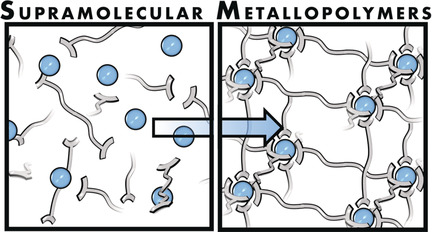
At the interface between coordination polymers and supramolecular metallopolymers, materials based on molecular weaving, supramolecular clusters, and metal-organic framework-polymer hybrids have emerged. This Minireview provides an intellectual roadmap from the development of supramolecular metallopolymers to new materials that blur the lines between metallopolymers and coordination polymers.
Reviews
Lithium Batteries
Electrolyte Additives for Lithium Metal Anodes and Rechargeable Lithium Metal Batteries: Progress and Perspectives
- Pages: 15002-15027
- First Published: 14 February 2018
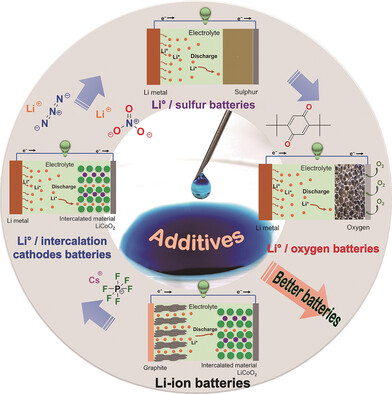
Better batteries: The use of electrolyte additives is considered one of the most viable, economical, and effective approaches to circumvent the problems of rechargeable Li metal batteries (LMBs). This Review assesses the current status of research on electrolyte additives for rechargeable LMBs and considers new avenues for the realization of these appealing devices.
Communications
Lithium Anodes
MXene Aerogel Scaffolds for High-Rate Lithium Metal Anodes
- Pages: 15028-15033
- First Published: 10 September 2018
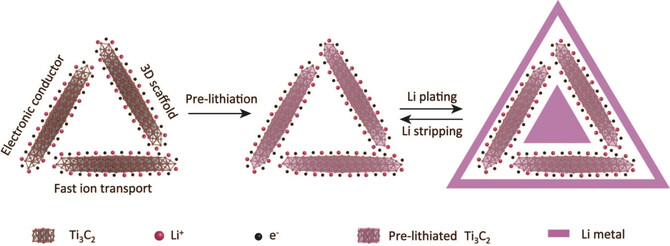
MXene aerogels: Li metal anodes can have a short lifespan and infinite volume expansion, and these challenges become more grievous under high current densities. 3D porous MXene aerogels are proposed as scaffolds for high-rate Li metal anodes. With high metallic electron conductivity, fast Li ion transport capability, and abundant Li nucleation sites, such scaffolds could deliver high cycling stability and low overpotentials at a high rate.
Molecular Switches
Reversible Photoswitching and Isomer-Dependent Diffusion of Single Azobenzene Tetramers on a Metal Surface
- Pages: 15034-15039
- First Published: 06 September 2018

Swift switching: Rigid azobenzene tetramers were assembled into hexamer patterns on a metal surface. The azobenzene unit oriented perpendicular to the surface could be isomerized reversibly with time constants of a few minutes, either remotely by light or locally by a scanning probe tip, thus leading to bright (trans) and dark features (cis) in STM images (see picture). The diffusion of individual species across the surface depended on their isomeric state.
Combination Therapy
Design of a Multicompartment Hydrogel that Facilitates Time-Resolved Delivery of Combination Therapy and Synergized Killing of Glioblastoma
- Pages: 15040-15044
- First Published: 21 September 2018
Methanol Synthesis
A Highly Active Molybdenum Phosphide Catalyst for Methanol Synthesis from CO and CO2
- Pages: 15045-15050
- First Published: 22 August 2018
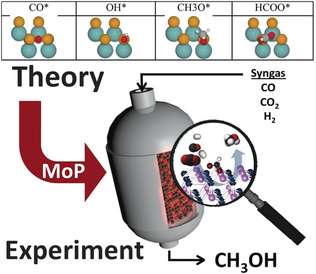
MoP-ed up: MoP is a new catalyst for CO and CO2 hydrogenation to methanol. By stabilizing only the monodentate binding configuration of formate, the phosphide is able to circumvent the (scaling) relationship between the necessary ability of the catalyst to bind oxygen-containing intermediates and catalyst deactivation resulting from high formate coverage in the presence of CO2.
NMR Spectroscopy
Avenues to Characterize the Interactions of Extended N-Glycans with Proteins by NMR Spectroscopy: The Influenza Hemagglutinin Case
- Pages: 15051-15055
- First Published: 20 September 2018
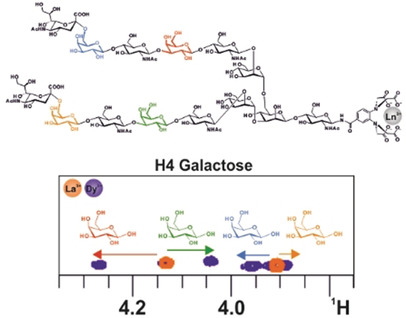
Tagging the flu: Conformational and interaction analysis of a sialylated tetradecasaccharide N-glycan with two LacNAc repetitions at each arm is presented. This glycan has been identified as the receptor of the hemagglutinin protein of pathogenic influenza viruses. An N-glycan conjugated with a lanthanide binding tag was synthesized, enabling analysis of the system by paramagnetic NMR spectroscopy.
Metalloenzymes
How [Fe]-Hydrogenase from Methanothermobacter is Protected Against Light and Oxidative Stress
- Pages: 15056-15059
- First Published: 12 September 2018
![How [Fe]-Hydrogenase from Methanothermobacter is Protected Against Light and Oxidative Stress](/cms/asset/5af69887-955e-417a-9c80-b7b21f47ab5c/anie201807203-toc-0001-m.jpg)
[Fe]-hydrogenase (Hmd) contains the iron–guanylylpyridinol (FeGP) cofactor, which is sensitive to UV-A/blue light and H2O2. In hexameric Hmd from Methanothermobacter marburgensis (mHmd), an expanded loop is detached from the dimer core and intrudes into the active site of a neighboring dimer. An aspartic acid (Asp) residue from the loop ligates to the Fe center. In the hexameric form, mHmd is protected against light and oxidative stress.
Enzyme Structures
The Crystal Structure of a Class of Cyclases that Catalyze the Cope Rearrangement
- Pages: 15060-15064
- First Published: 17 September 2018
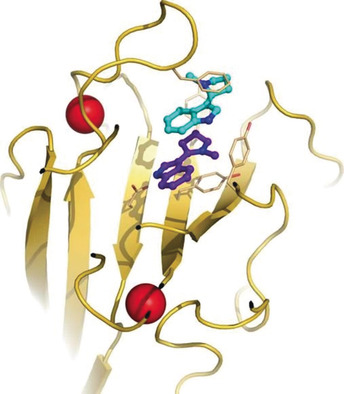
Complex structure elucidations of Stig cyclases reveal a common substrate-binding mode and mechanism of action of these enzymes. Located near the bottom of a terminal cavity in the β-sandwich, a strictly conserved aspartate plays a vital role in catalysis, while the surrounding active-site residues including those in the overhanging loop may determine the type of cyclization and the final product.
Molecular Electronics
Breakdown of Curly Arrow Rules in Anthraquinone
- Pages: 15065-15069
- First Published: 12 September 2018
Water Splitting
Carbon Nanotubes with Cobalt Corroles for Hydrogen and Oxygen Evolution in pH 0–14 Solutions
- Pages: 15070-15075
- First Published: 22 September 2018
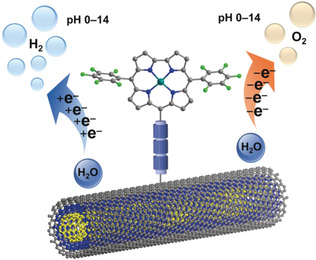
pH range rover: A hybrid material allowing fast electron transfer between cobalt corroles and carbon nanotubes (CNTs) catalyzes the hydrogen evolution reaction (HER) and the oxygen evolution reaction (OER) in pH 0–14 aqueous solutions with high efficiency and stability. This is the first example of bifunctional HER and OER catalysts that work in such wide pH range.
Water Oxidation Catalysts
Construction of Heterostructured Fe2O3-TiO2 Microdumbbells for Photoelectrochemical Water Oxidation
- Pages: 15076-15080
- First Published: 24 September 2018

A weighty performance: A heterostructured Fe2O3-TiO2 microdumbbell photocatalyst is fabricated through a facile synthetic approach. With their novel heterojunction structure, the well-defined Fe2O3-TiO2 microdumbbells exhibit enhanced photoelectrochemical performance compared to Fe2O3 microrods, TiO2 nanospheres, and mixtures of the two.
Trifluoromethylation | Very Important Paper
Divergent Reactivity of Stannane and Silane in the Trifluoromethylation of PdII: Cyclic Transition State versus Difluorocarbene Release
- Pages: 15081-15085
- First Published: 11 September 2018
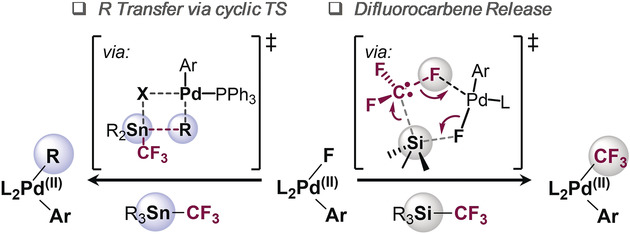
Transmetalation is a key elementary step in cross-coupling reactions. The precise nature of its mechanism and transition state geometry are frequently elusive. This Communication discloses studies of the transmetalation of [PdII]-F complexes with the silane- and stannane-based trifluoromethylation agents R3SiCF3 and R3SnCF3.
Metal–Organic Frameworks
Origin of the Chemiresistive Response of Ultrathin Films of Conductive Metal–Organic Frameworks
- Pages: 15086-15090
- First Published: 20 September 2018
Supramolecular Chemistry
Cavitands as Containers for α,ω-Dienes and Chaperones for Olefin Metathesis
- Pages: 15091-15095
- First Published: 23 September 2018

Rough and tumble: Hydrophobic forces drive α,ω-dienes into cavitands in conformations that best fill the available space. Shorter dienes (C9 and C10) bind in compressed conformations that tumble rapidly within the cavitands. The cavitands enhanced the synthesis of medium-sized cycloalkenes by ring-closing metathesis compared with reactions of the free dienes in either aqueous media or chloroform.
Asymmetric Catalysis
C2-Symmetric Bicyclic Bisborane Catalysts: Kinetic or Thermodynamic Products of a Reversible Hydroboration of Dienes
- Pages: 15096-15100
- First Published: 13 September 2018

B,B bicycles: A new class of C2-symmetric bicyclic bisborane catalysts was synthesized by treating bicyclic dienes with HB(C6F5)2 or HB(p-C6F4H)2. Remarkably, two diastereomeric catalysts could be accessed selectively from a single diene precursor by simply varying the reaction temperature (see scheme). These catalysts exhibited excellent activity and selectivity in the hydrogenation of imines.
Electrocatalysis | Hot Paper
An Efficient Anti-poisoning Catalyst against SOx, NOx, and POx: P, N-Doped Carbon for Oxygen Reduction in Acidic Media
- Pages: 15101-15106
- First Published: 11 September 2018
Stereodynamics
A Stereodynamic Redox-Interconversion Network of Vicinal Tertiary and Quaternary Carbon Stereocenters in Hydroquinone–Quinone Hybrid Dihydrobenzofurans
- Pages: 15107-15111
- First Published: 19 September 2018
Non-Covalent Interactions
Nucleic Acids | Very Important Paper
N6-Methyladenosine-Sensitive RNA-Cleaving Deoxyribozymes
- Pages: 15117-15121
- First Published: 01 October 2018
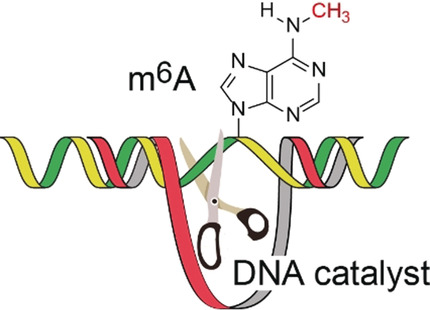
Meet the methyl mark: Site-specific RNA-cleaving deoxyribozymes are reported that respond to the presence of N6-methyladenosine close to the cleavage site in RNA with enhanced or strongly diminished cleavage rates, and thereby directly reveal the presence of the epitranscriptomic m6A modification in the target RNA.
Hydrogels
A Modular Approach to Sensitized Two-Photon Patterning of Photodegradable Hydrogels
- Pages: 15122-15127
- First Published: 06 September 2018
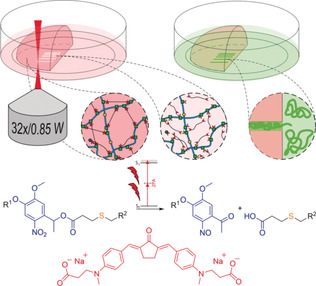
Sensitized micropatterning of photodegradable hydrogels by means of two-photon irradiation is possible. The efficiency of the photoscission of o-nitrobenzyl ester linkages is enhanced by the modular addition of a two-photon active small molecule to a preformed hyaluronic acid based hydrogel. Biocompatibility of the improved two-photon micropatterning process as well as the hydrogel is confirmed by cell culture studies.
Automated Synthesis
Across-the-World Automated Optimization and Continuous-Flow Synthesis of Pharmaceutical Agents Operating Through a Cloud-Based Server
- Pages: 15128-15132
- First Published: 01 October 2018
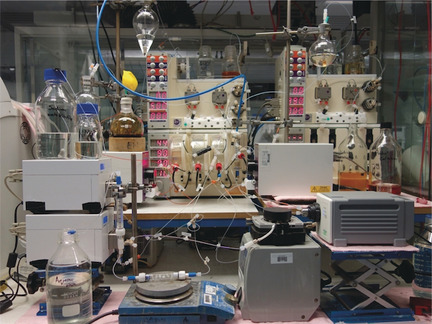
The power of the Cloud was harnessed for pharmaceutical compound production. Servers in Japan autonomously optimized conditions for three active pharmaceutical ingredients synthesized in laboratories in the UK. A researcher in the USA controlled the process via an internet connection. The synthetic steps were optimized with minimal intervention from operators within hours for all examples.
Methane
Methane Hydration-Shell Structure and Fragility
- Pages: 15133-15137
- First Published: 18 October 2018
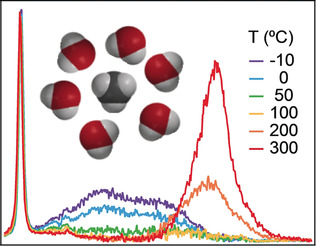
The shape of water: The influence of methane on the structure of liquid water is elucidated using Raman hydration-shell vibrational spectroscopic measurements. Near ambient temperatures, methane's hydration-shell is found to be slightly more tetrahedral than pure water, and then at higher temperatures it undergoes a crossover to a more disordered structure.
Enantiospecific Borylation | Hot Paper
Highly Enantiospecific Borylation for Chiral α-Amino Tertiary Boronic Esters
- Pages: 15138-15142
- First Published: 05 October 2018

Enantiospecific borylation: A highly enantiospecific borylation of configurationally stable α-N-Boc substituted tertiary organolithium species and HBpin has been developed to synthesize various α-amino tertiary boronic esters through the formation of a new C−B bond with excellet enantiopurity and complete retention of configuration.
Cross-Coupling
Manganese-Catalyzed Dual-Deoxygenative Coupling of Primary Alcohols with 2-Arylethanols
- Pages: 15143-15147
- First Published: 26 October 2018

“Mn” of action: A general and efficient dual-deoxygenative coupling of primary alcohols with 2-arylethanols, catalyzed by a well-defined manganese/PNP pincer complex, is reported. Mechanistic studies indicate that this transformation undergoes a reaction process involving catalytic dehydrogenation, aldol condensation, and base-promoted deformylation.
Helical Structures
Double-Helical Nanostructures with Controllable Handedness in Bulk Diblock Copolymers
- Pages: 15148-15152
- First Published: 17 September 2018
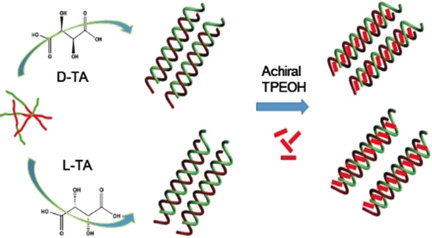
Take control: Double-stranded helices with clear and controllable handedness were constructed in a bulk block copolymer by using d- and l-tartaric acid (TA) as dopants. The helices showed clear handedness dependence on the configuration of the TA. These helical structures induced different achiral species, such as nanoparticles and organic molecules, to adopt a chiral arrangement (see picture; TPEOH=4-[2-(4-hydroxyphenyl)-1,2-diphenylethenyl]phenol).
Electroorganic Synthesis | Hot Paper
Cathode Material Determines Product Selectivity for Electrochemical C−H Functionalization of Biaryl Ketoximes
- Pages: 15153-15156
- First Published: 17 September 2018
Phosphorus Heterocycles
Diphosphahexaarenes as Highly Fluorescent and Stable Materials
- Pages: 15157-15161
- First Published: 24 October 2018
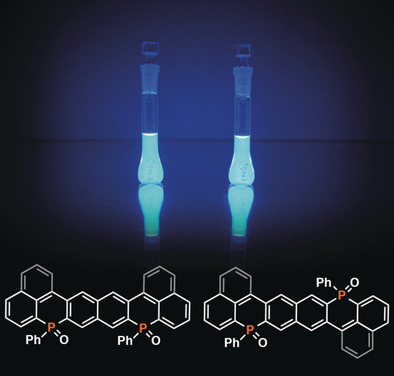
Two P rings in a line: The straightforward preparation of linearly fused systems containing two six-membered phosphorus heterocycles, diphosphahexaarenes, is presented (see structures). They are very stable towards air, moisture and light. Optoelectronic investigations revealed ambipolar redox behavior for all derivatives and high fluorescence quantum yields up to 0.85.
Natural Products Synthesis
Mannich-type Reactions of Cyclic Nitrones: Effective Methods for the Enantioselective Synthesis of Piperidine-containing Alkaloids
- Pages: 15162-15166
- First Published: 01 October 2018
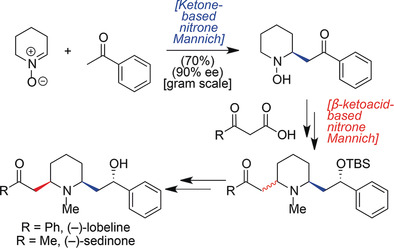
Just Mannich enough: Despite their prevalence, 2- and 2,6-disubstituted piperidines are challenging to prepare enantioselectively, particularly when they possess β-functionalization. Two new approaches based on the use of cyclic nitrones provide the means to readily fashion an array of such materials, one of which proceeds with high enantioselectivity (up to 98 % ee) using a chiral thiourea promoter. Their sequential use has enabled 8-step total syntheses of both (−)-lobeline and (−)-sedinone from a common intermediate.
Thermoelectric Materials
Stabilizing n-Type Cubic GeSe by Entropy-Driven Alloying of AgBiSe2: Ultralow Thermal Conductivity and Promising Thermoelectric Performance
- Pages: 15167-15171
- First Published: 17 September 2018
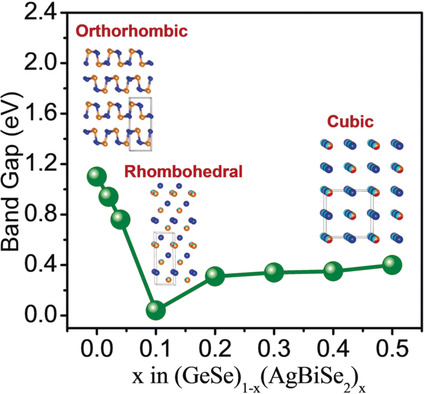
n-Type cubic GeSe has been stabilized at ambient conditions by entropy-driven formation of a solid solution with AgBiSe2. It demonstrated promising thermoelectric properties with ultralow thermal conductivity. Upon increasing the AgBiSe2 concentration in GeSe, the band gap of the system changes anomalously.
Erbium Complexes
Room-Temperature Linear Light Upconversion in a Mononuclear Erbium Molecular Complex
- Pages: 15172-15176
- First Published: 28 September 2018
Hydrogenation | Hot Paper
Simple Alkaline-Earth Metal Catalysts for Effective Alkene Hydrogenation
- Pages: 15177-15182
- First Published: 19 September 2018
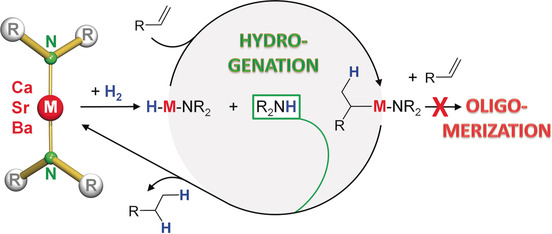
Keep it simple: The widely used, easily accessible, alkaline earth metal amides M(NR2)2 (M=Ca, Sr, Ba, R=SiMe3) are highly active alkene hydrogenation catalysts. Alkene oligomerization is fully suppressed by trapping the reactive intermediate with R2NH. A first example of Group 2 metal hydrogen transfer catalysis is given.
Gas Separation | Hot Paper
A Metal–Organic Framework with Suitable Pore Size and Specific Functional Sites for the Removal of Trace Propyne from Propylene
- Pages: 15183-15188
- First Published: 21 September 2018
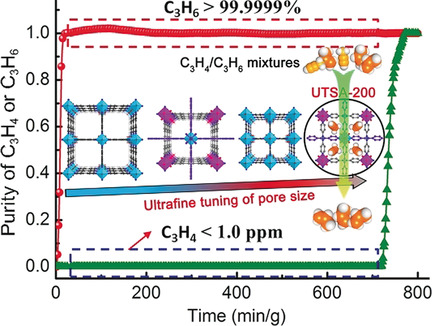
Record removal: A series of metal–organic frameworks with broad types of structures, pore sizes, and functionalities were used to identify UTSA-200 as the best separating agent for removal of trace C3H4 from C3H4/C3H6 mixtures. The efficiency is mainly attributed to the optimally dynamic pore size to efficiently block the larger C3H6 whilst retaining strong binding sites to selectively take up C3H4, thus producing high-purity C3H6 (99.9999 %).
Donor–Acceptor Structures
Strategies to Enhance the Photosensitization: Polymerization and the Donor–Acceptor Even–Odd Effect
- Pages: 15189-15193
- First Published: 25 September 2018
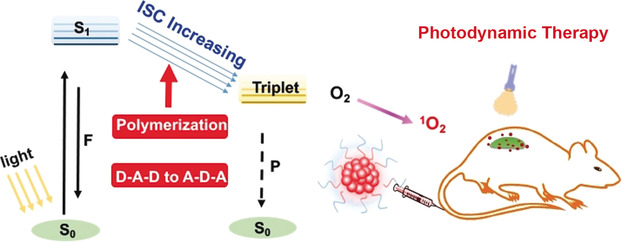
Conjugated polymers have a higher 1O2 generation efficiency than their small molecular counterparts. Photosensitizers with A-D-A structures are better than D-A-D structures. Both in vitro and in vivo experiments show that the resulting materials can be used as photosensitizers in image-guided photodynamic anticancer therapy. D=donor, A=acceptor.
Single-Atom Catalysis | Very Important Paper
Grouping Effect of Single Nickel−N4 Sites in Nitrogen-Doped Carbon Boosts Hydrogen Transfer Coupling of Alcohols and Amines
- Pages: 15194-15198
- First Published: 25 September 2018
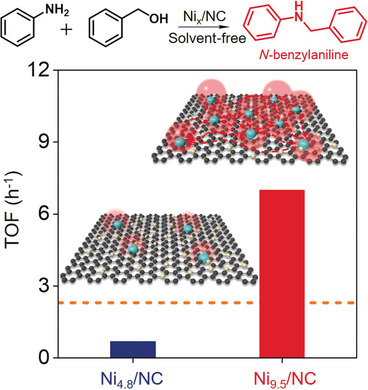
Herd instinct: A grouping effect is observed for single Ni−N4 sites in a Ni catalyst supported by nitrogen-doped carbon (NC). A high 9.5 wt % Ni content was achieved with a ligand-stabilized polycondensation method. An enhanced electron density effect manifests at each single Ni−N4 site, which decreases the binding energy of H radicals to Ni and promotes efficient coupling of benzyl alcohol and aniline to form N-benzylaniline.
Hydrogen Bonding
The H2S Dimer is Hydrogen-Bonded: Direct Confirmation from Microwave Spectroscopy
- Pages: 15199-15203
- First Published: 28 September 2018
Asymmetric Catalysis
Copper-Catalyzed Ring Opening of Benzofurans and an Enantioselective Hydroamination Cascade
- Pages: 15204-15208
- First Published: 24 September 2018

Opening up: A copper(II) acetate/(R)-DTBM-SEGPHOS-catalyzed ring opening of benzofurans and an enantioselective hydroamination cascade with dimethoxymethylsilane (DMMS) and hydroxylamine esters is described. Starting from readily available substituted benzofurans, a series of chiral N,N-dibenzylaminophenols, which are of high interest in pharmaceutical chemistry, were obtained with excellent enantioselectivity.
Natural Products
Total Syntheses of Bisdehydroneostemoninine and Bisdehydrostemoninine by Catalytic Carbonylative Spirolactonization
- Pages: 15209-15212
- First Published: 19 September 2018
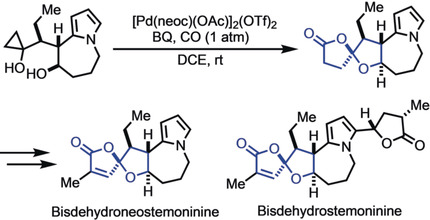
Core strength: The first total syntheses of the stemona alkaloids bisdehydroneostemoninine and bisdehydrostemoninine are reported. The synthesis features a novel palladium-catalyzed carbonylative spirolactonization to rapidly construct the oxaspirolactone moiety and a Lewis acid promoted tandem Friedel–Crafts cyclization and lactonization to form the 5-7-5 tricyclic core of the target alkaloids.
Annulation
Enantioselective Synthesis of Indolines, Benzodihydrothiophenes, and Indanes by C−H Insertion of Donor/Donor Carbenes
- Pages: 15213-15216
- First Published: 07 September 2018
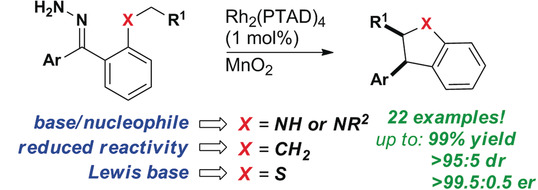
The Carbene Abides: Rhodium carbenes derived from substrates with no electron-withdrawing groups enable the highly selective syntheses of indolines and benzodihydrothiophenes. The reactions reported here represent the broadest level of functional-group tolerance yet demonstrated for enantioselective C−H insertion. A single catalyst/oxidant system is employed for all substrates and in most cases C−H insertion proceeds as a one-pot process from the hydrazone.
Synthetic Methods
Diastereo- and Enantioselective Propargylation of 5H-Thiazol-4-ones and 5H-Oxazol-4-ones as Enabled by Cu/Zn and Cu/Ti Catalysis
- Pages: 15217-15221
- First Published: 19 September 2018
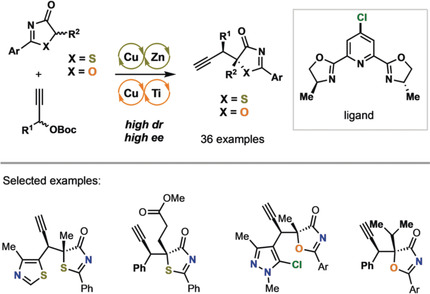
‘CuTi' pie: Cu/Zn and Cu/Ti dual metal systems have been devised to achieve the highly diastereo- and enantioselective propargylic substitution of 5H-thiazol-4-ones and 5H-oxazol-4-ones, respectively. These reactions demonstrate substantial substrate scope, giving terminal-alkyne-containing, functional-group-rich products in high yields.
B(C6F5)3/Amine-Catalyzed C(sp)−H Silylation of Terminal Alkynes with Hydrosilanes: Experimental and Theoretical Studies
- Pages: 15222-15226
- First Published: 25 September 2018

Double duty: The combination of B(C6F5)3 and an organic base, such as triethylenediamine (DABCO), serve as an excellent catalytic system for the C(sp)−H silylation of terminal alkynes with hydrosilanes. DABCO plays two crucial roles (Lewis base and Brønsted base) as revealed by experimental and DFT studies.
Borylation
Selective C−N Borylation of Alkyl Amines Promoted by Lewis Base
- Pages: 15227-15231
- First Published: 25 September 2018

N to B: A mild catalytic system was developed for the preparation of alkyl potassium trifluoroborate salts by C−N bond cleavage. This method has good functional-group compatibility and can serve as a powerful synthetic tool for late-stage borylative cleavage of C−N bonds in complex compounds. dtbpy=4,4′-di-tert-butyl-2,2′-bipyridine.
Alkaloids
Iodospirocyclization of Tryptamine-Derived Isocyanides: Formal Total Synthesis of Aspidofractinine
- Pages: 15232-15236
- First Published: 01 October 2018

I make(s) spirocycles: Iodospirocyclization of tryptamine-derived isocyanides affords highly substituted spiroindolenine imidoyl iodides. The imine functionality can undergo a variety of diastereoselective addition reactions, including in situ reduction, while the imidoyl iodide functionality is remarkable stable. The utility of the method was demonstrated by the formal total synthesis of (±)-aspidofractinine.
Electrocatalysis
Structurally Ordered Intermetallic Cobalt Stannide Nanocrystals for High-Performance Electrocatalytic Overall Water-Splitting
- Pages: 15237-15242
- First Published: 24 September 2018
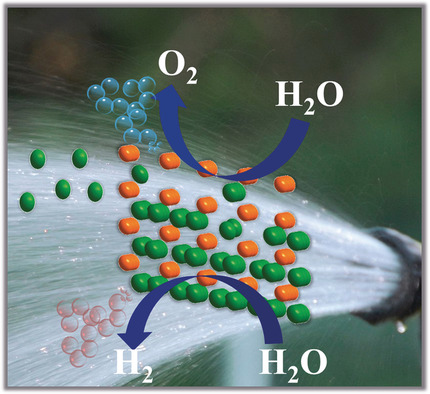
When two become one: The first tetragonal intermetallic cobalt stannide electrocatalyst, produced through diffusion of Co and Sn, acts as a superiorly active material for the electrocatalytic oxygen evolution and hydrogen evolution reaction as well as for overall water-splitting in strongly alkaline media. The self-supporting structural and electronic factors of Co and Sn enable enhanced net catalytic activities and long-lasting stability.
Drug Discovery
Antibody–Drug Conjugates with Pyrrole-Based KSP Inhibitors as the Payload Class
- Pages: 15243-15247
- First Published: 04 September 2018

Flexible, stable, potent: Inhibitors of kinesin spindle protein (KSP) have been developed as a novel payload class in antibody–drug conjugates (ADCs) with the goal to increase the therapeutic window. Flexibility in linker attachment and tuning of the profile of active metabolites matching the KSPi mode of action as well as high linker stability provide potent ADCs against different targets.
C−C Coupling | Hot Paper
Non-Directed Cross-Dehydrogenative (Hetero)arylation of Allylic C(sp3)−H bonds enabled by C−H Activation
- Pages: 15248-15252
- First Published: 28 August 2018

Catch desired couplings: The non-directed cross-dehydrogenative coupling of allylic C(sp3)−H bonds with (hetero)arene C(sp2)−H bonds is enabled by C−H activation and employs abundant chemical feedstocks: olefins and (hetero)arenes. A particular highlight of this mild reaction is the applicability in late-stage functionalization reactions.
Reductions
Electrophilic Phosphonium Cation-Mediated Phosphane Oxide Reduction Using Oxalyl Chloride and Hydrogen
- Pages: 15253-15256
- First Published: 19 September 2018
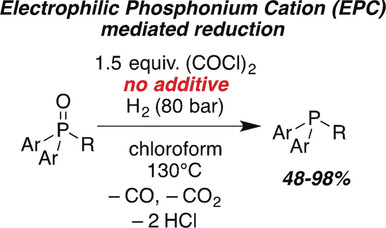
The metal-free reduction of phosphane oxides with H2 using oxalyl chloride as activating agent was achieved. H2 is activated by the in situ formed electrophilic phosphonium cation and phosphane oxide. The reaction is also catalyzed by B(2,6-F2C6H3)3 and 2,6-lutidine or phosphane oxide as Lewis base.
Photolithography
High-Density RNA Microarrays Synthesized In Situ by Photolithography
- Pages: 15257-15261
- First Published: 06 September 2018
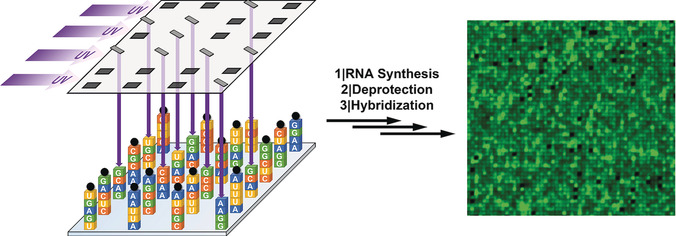
The nucleotides have turned: Using photolithography, phosphoramidite chemistry and a new set of base-sensitive monomers, mixed-base RNA microarrays can now be synthesized in situ. RNA arrays fabricated at high-density can accommodate up to about 780 000 different sequences inside a small, approximately 1.5 cm2 wide synthesis area. The concept is illustrated with the synthesis of all possible 9-nt long sequence permutations.
Protein Dynamics | Hot Paper
Local and Global Dynamics in Intrinsically Disordered Synuclein
- Pages: 15262-15266
- First Published: 05 September 2018
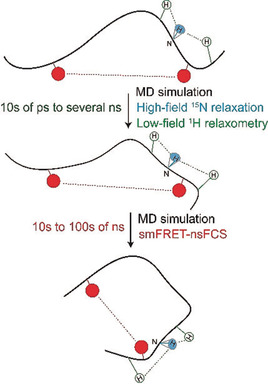
Three techniques combined: Capturing local and global dynamics from one to hundreds of nanoseconds in the intrinsically disordered protein (IDP) α-synuclein: the combination of three experimental techniques, which are sensitive to motions on different length and timescales, with long molecular dynamics simulations is a powerful strategy to determine residue-specific protein dynamics in IDPs.
Frustrated Lewis Pairs
Single-Electron Transfer Reactions in Frustrated and Conventional Silylium Ion/Phosphane Lewis Pairs
- Pages: 15267-15271
- First Published: 03 September 2018
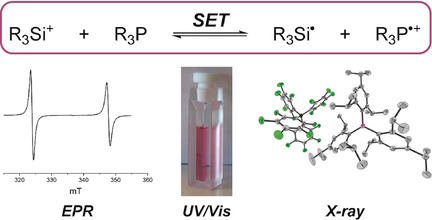
An electron against frustration! Silylium ions accept an electron from sterically hindered triarylphosphanes, regardless of whether these Lewis acids form a frustrated or a classical Lewis pair with the phosphane Lewis base. The thus-generated phosphoniumyl radical cations were characterized by EPR and UV/Vis absorption spectroscopy and single-crystal X-ray diffraction (see picture).
Nucleophilic Boron | Very Important Paper
Facile Synthesis of a Stable Dihydroboryl {BH2}− Anion
- Pages: 15272-15275
- First Published: 20 September 2018
Cycloadditions | Very Important Paper
Chelated Diborenes and Their Inverse-Electron-Demand Diels–Alder Reactions with Dienes
- Pages: 15276-15281
- First Published: 11 September 2018




